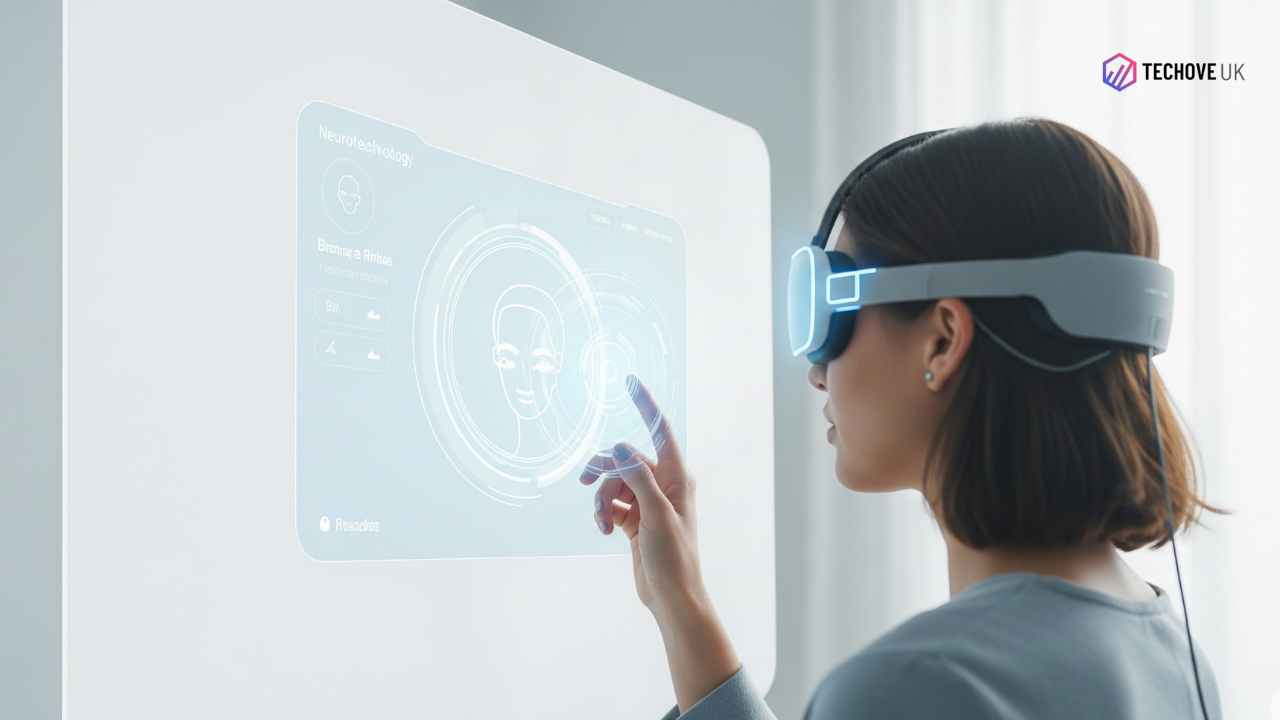What Will Be the User Experience for Neurotechnology? A Guide for Professionals
(Image: A subtly futuristic image depicting a person comfortably interacting with a sleek, non-invasive neurotech device – perhaps a headband or subtle ear-worn piece. Focus on calm, positive interaction, not a sterile lab setting.)
Did you know that scientists are already using brain-computer interfaces to allow paralyzed individuals to control robotic limbs with their thoughts? It sounds like science fiction, right? But it’s happening now. And it’s just the tip of the iceberg. In this guide, we’ll explore the evolving user experience (UX) of neurotechnology – from its current, often clunky beginnings to the seamless, intuitive future it promises. Whether you’re a healthcare professional, a tech innovator, a designer, or simply someone fascinated by the intersection of brain and machine, you’ll walk away with a clear understanding of what to expect, the challenges ahead, and the incredible potential of this rapidly developing field.
Let’s dive in!
Understanding the Current Landscape: It’s Not Always Smooth Sailing
For many, the image of neurotechnology conjures up scenes from movies like The Matrix or Limitless. The reality, today, is a little more…practical. Currently, neurotech UX varies wildly depending on the invasiveness of the technology.
Invasive Neurotech: Think implanted electrodes, like those used in deep brain stimulation (DBS) for Parkinson’s disease. While incredibly effective for specific medical conditions, the UX is understandably complex. It involves surgery, recovery, ongoing adjustments, and a significant commitment from the patient. The “user experience” isn’t just about using the device; it’s about living with it. Imagine needing regular check-ups to calibrate a device controlling essential motor functions. It’s life-changing, yes, but also demanding.
Non-Invasive Neurotech: This is where things get really interesting – and where most of the near-future UX development will focus. We’re talking about technologies like EEG (electroencephalography) headsets, tDCS (transcranial direct current stimulation) devices, and fNIRS (functional near-infrared spectroscopy). These methods measure or stimulate brain activity without surgery. However, even these “non-invasive” options aren’t always user-friendly.
Think about trying to get a perfect signal with a traditional EEG cap. It requires skilled technicians to apply the electrodes, and even then, movement or changes in skin conductivity can introduce noise. It’s not exactly a “plug and play” experience. Early tDCS devices were often bulky and required precise electrode placement, making home use challenging.
The core problem? Current non-invasive methods often struggle with signal quality, comfort, and ease of use. They can feel cumbersome, require specialised knowledge, and deliver inconsistent results. This creates a barrier to wider adoption, even for technologies with proven benefits.
The Pillars of a Positive Neurotech UX: What Users Will Demand
So, what does a good neurotech UX look like? It’s not just about making the technology work; it’s about making it feel good to use. Here are the key pillars:
Seamless Integration: This is paramount. Users won’t tolerate devices that are clunky, uncomfortable, or require constant fiddling. Imagine a future where neurotech is integrated into everyday objects – headphones that monitor your stress levels, glasses that enhance focus, or even clothing that provides subtle brain stimulation to improve mood. The goal is for the technology to fade into the background, becoming an intuitive extension of the user.
Personalisation & Adaptability: Every brain is unique. A “one-size-fits-all” approach simply won’t work. Neurotech needs to learn and adapt to the individual user’s brain activity, preferences, and goals. Think of it like a personalised learning algorithm, but for your brain. The device should adjust stimulation parameters, feedback mechanisms, and even the interface itself based on your specific needs.
Clear & Actionable Feedback: What’s the point of measuring brain activity if you can’t understand what it means? Users need clear, concise, and actionable feedback. Instead of raw EEG data, imagine a system that translates brainwaves into simple metrics like “focus level,” “stress score,” or “emotional state.” This information can then be used to guide interventions, such as guided meditation, personalized music playlists, or even adaptive learning exercises.
Safety & Trust: This is non-negotiable. Users need to be confident that neurotech is safe and won’t cause any harm. This requires rigorous testing, transparent data privacy policies, and clear communication about potential risks and benefits. Building trust is crucial for widespread adoption. Would you willingly use a device that could potentially alter your brain activity if you didn’t fully understand the implications?
Ethical Considerations: As neurotech becomes more powerful, ethical concerns become increasingly important. How do we prevent misuse of the technology? How do we protect user privacy? How do we ensure equitable access? These are complex questions that need to be addressed proactively.
The Technologies Shaping the Future UX
Several emerging technologies are poised to revolutionise the neurotech UX:
Dry EEG Sensors: Traditional EEG requires conductive gel to ensure good contact between the electrodes and the scalp. Dry EEG sensors eliminate the need for gel, making the process faster, cleaner, and more comfortable. This is a huge step towards making EEG more accessible for everyday use.
Miniaturisation & Wearables: We’re seeing a trend towards smaller, more discreet neurotech devices. Headbands, ear-worn sensors, and even smartwatches are incorporating brain-sensing capabilities. This makes the technology more convenient and less stigmatizing.
Advanced Signal Processing & AI: Artificial intelligence (AI) is playing a crucial role in improving signal quality and extracting meaningful insights from brain data. AI algorithms can filter out noise, identify patterns, and personalize the user experience. Imagine an AI that can predict when you’re about to lose focus and proactively adjust stimulation parameters to help you stay on track.
Closed-Loop Systems: These systems continuously monitor brain activity and adjust stimulation parameters in real-time. This creates a dynamic feedback loop that optimizes the user experience. For example, a closed-loop system could detect when you’re feeling stressed and automatically deliver a calming brain stimulation protocol.
Neuromodulation via Ultrasound: Transcranial focused ultrasound (tFUS) is an emerging non-invasive neuromodulation technique that offers precise targeting and deeper penetration than tDCS. This could lead to more effective and targeted brain stimulation therapies.
Neurotech UX Across Different Applications: A Glimpse into the Future
Let’s look at how the UX might evolve in specific applications:
Mental Health: Imagine a wearable device that detects early signs of anxiety or depression and provides personalized interventions, such as guided meditation or cognitive behavioral therapy exercises. The UX would be focused on providing support and empowerment, helping users manage their mental health proactively.
Cognitive Enhancement: Neurotech could be used to improve focus, memory, and learning. The UX would be designed to be seamless and unobtrusive, enhancing cognitive performance without causing distractions. Think of a headband that subtly stimulates your brain to help you stay focused during a long meeting.
Gaming & Entertainment: Brain-computer interfaces could revolutionize gaming by allowing players to control games with their thoughts. The UX would be immersive and engaging, creating a new level of interactivity. Imagine controlling a character in a video game simply by imagining the actions you want them to perform.
Rehabilitation: Neurotech can help patients recover from stroke, traumatic brain injury, and other neurological conditions. The UX would be focused on providing personalized therapy and tracking progress. Imagine a system that uses brain-computer interfaces to help paralyzed individuals regain movement in their limbs.
Challenges & Opportunities: The Road Ahead
Despite the incredible potential, several challenges remain:
-
- Data Privacy & Security: Protecting sensitive brain data is paramount. Robust security measures and transparent data privacy policies are essential.
-
- Regulatory Hurdles: Neurotech is a rapidly evolving field, and regulations are still catching up. Clear and consistent regulatory frameworks are needed to ensure safety and promote innovation.
-
- Accessibility & Affordability: Neurotech needs to be accessible to everyone, not just the wealthy. Efforts are needed to reduce costs and make the technology more widely available.
-
- User Education: Many people are still unfamiliar with neurotech. Education and outreach are needed to dispel myths and build trust.
However, these challenges also present opportunities. By addressing these issues proactively, we can unlock the full potential of neurotechnology and create a future where brain-machine interfaces enhance our lives in profound ways.
The future of neurotech UX isn’t about replacing the human experience; it’s about enhancing it. It’s about empowering individuals to take control of their brains, improve their well-being, and unlock their full potential. It’s a future worth striving for.



